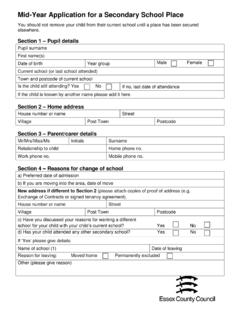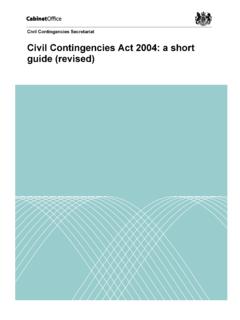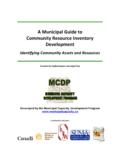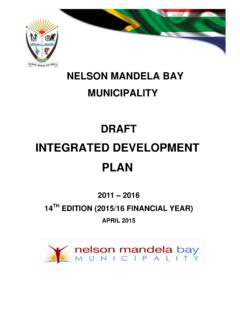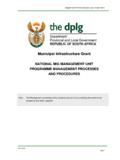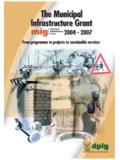Transcription of Essex Waste Strategy
1 Joint municipal Waste Management Strategy for Essex (2007 to 2032). CONTENTS. Page 1 EXECUTIVE SUMMARY 4. 2 INTRODUCTION 6. - A Waste Management Strategy for the people of Essex 6. - The current situation 7. - The need for change 8. - Community involvement 8. - EU Landfill Directive 9. - Landfill Tax 10. - Landfill void space 11. - The Waste Strategy for England 2007 11. 3 WHERE ARE WE NOW? 12. - Description of current services 12. - Current costs 14. - Waste arisings 15. - Analysis of current performance 15. - Reduction 15. - Recycling 15. - National Indicators 15. - Waste composition 16. - Current Waste reduction, reuse and recycling initiatives and campaigns 17. - Reduction 17. 1. - Reuse 18. - Recycling 20. - Waste Education 21. - Evaluation of Initiatives 22. 4 WHERE DO WE WANT TO GET TO? 22. - The Waste hierarchy 22. - Future Waste Growth 24. - Resource management 26. - Targets for Essex 26.
2 - Waste reduction 26. - Recycling Targets 27. - Climate Change, Energy 28. - Technology Choice 29. - Best Practicable Environmental Option (BPEO) 31. - Strategic Environmental Assessment (SEA) 31. - The Partnership's response to the Landfill Allowance Trading Scheme (LATS) 32. - Costs 33. 5 HOW WILL WE GET THERE? 33. - Community involvement 33. - Partnership Working 34. - External Partnerships 35. - Planning and permitting of new facilities 36. 2. - Urban Design 37. - Equality and Diversity 38. - Funding 38. - Governance 39. - Commitment 39. - Risk management 39. - Timely delivery of services and facilities 39. - LATS risk 40. - General risk assessment 40. - Monitoring and review of the Strategy 40. Annex 1 Glossary of terms Annex 2 Development of the Strategy Annex 3 Consultation and community engagement Annex 4 Waste Management Advisory Board terms of reference (2002). Annex 5 Legislative drivers Annex 6 Performance and data information Annex 7 Current service provision, as at July 2008.
3 3. EXECUTIVE SUMMARY. The Essex situation In 2007/08 Essex produced approximately 732,400 tonnes of municipal solid Waste 1, the majority of which was household Waste . On average, each Essex resident produces about half a tonne of Waste in a year. 38% of the household Waste was recycled or composted in 2007/08. This recycling was undertaken by a combination of householders sorting their Waste for recycling collections at the kerbside, taking recyclables to bring banks, or by taking sorted materials to their local Recycling Centre for Household Waste . The Need for Change Essex has improved its recycling rate each year, but we all need to do more. Too much Waste is still ending up in landfill sites, so valuable resources are lost. This needs to change. Sending untreated Waste to landfill is not a sustainable way of managing Waste . This has been recognised in European and national law which now require local authorities to reduce the amount of biodegradable Waste 2 that they dispose of in landfill sites.
4 The County Council has therefore been set challenging landfill diversion targets by Government and all Essex authorities have local recycling targets to meet. One of the key objectives of this Strategy is to achieve high levels of recycling, with an aspiration to achieve collectively 60% recycling of household Waste by 2020. However, high levels of recycling alone are not enough for us to meet these targets. In order to deliver an innovative and resource efficient Waste management system for Essex we need to invest in new technologies which treat the residual Waste and which can extract further value and recyclable materials from the Waste . Waste management is one of the biggest challenges facing Essex now and in the future. To tackle this challenge and develop a sustainable Strategy that is supported by Essex householders and key stakeholders, the County Council and the twelve District and Borough Councils of Essex have formed an Essex Waste Partnership (this also includes Southend-on-Sea Borough Council, although as a unitary authority, Southend-on-Sea has developed its own Waste Strategy ).
5 1. municipal Waste is household Waste and any other Waste that is collected for treatment and disposal by a local authority. 2. Biodegradable Waste is Waste that rots down. It includes things like paper, card, food and garden Waste 4. Throughout this document you will see a series of green boxes; these are the key targets and objectives for the Essex Waste Partnership. Strategy Themes Essex 's proposed Strategy for dealing with municipal Waste in the future can be summarised as follows: Essex Authorities will work hard to reduce the amount of Waste produced in the first place and re-use more of the Waste that is produced;. Essex will achieve high levels of recycling, with an aspiration to achieve collectively 60% recycling of household Waste by 2020. This could be achieved through a combination of further improvement in the performance of recycling and composting kerbside collection schemes and the Recycling Centres for Household Waste , and the recovery of recyclable materials through new treatment plants.
6 Essex favours composting technologies such as anaerobic digestion (AD), for source segregated organic wastes. AD is a form of biotreatment and produces a gas which can be used to generate 100% renewable electricity;. Whilst we can work on reducing the amount of Waste produced and recycling as much of if it as possible, there will always be some Waste that still needs to be disposed of. For this we propose to introduce new treatment plants using Mechanical Biological Treatment (MBT). MBT processes any black bag'. Waste and recovers further material for recycling. Part of the remaining material can either be manufactured into a fuel for energy production or can be sent to landfill. Monitoring and Review An action plan will be developed to provide more details on how Essex authorities will deliver the key targets and activities outlined in this Strategy . This will be supported by service delivery plans for each authority.
7 The action plan will be subject to annual monitoring and reviews. The Strategy will be reviewed every three to five years. The main purpose of the reviews will be to assess the extent to which the collective activities of the partners have furthered the objectives of the Strategy . 5. INTRODUCTION. A Waste management Strategy for the people of Essex This draft Joint municipal Waste Management Strategy (JMWMS) has been developed by the thirteen Waste authorities of Essex , comprising Essex County Council, as the Waste Disposal Authority (WDA), and the twelve District and Borough Councils, as the Waste Collection Authorities (WCAs), in Essex . It constitutes a 25 year plan for the future of recycling and Waste management in Essex . In 2002 the County Council, the District and Borough Councils together with the unitary authorities of Southend-on-Sea Borough Council and Thurrock Council 3, set up an advisory board to examine how to deal with municipal Waste in these areas over the next two decades.
8 This Waste Management Advisory Board (WMAB) has looked at the current and future challenges regarding Waste and has examined a range of ways of dealing with it. The WMAB has always believed strongly in the importance of involving the people of Essex in the development of this Strategy . Consequently, public consultation exercises were conducted during 2002 and 2005 and the outcomes have informed the development of this document. The Strategy brings together the views of the public, key stakeholders and the Essex authorities and sets out options for how Waste should be managed in the future. Southend-on-Sea Borough Council published its own municipal Waste Management Strategy for the Borough of Southend-on-Sea in June 2004 and the Strategy identifies joint working with other Essex local authorities as highly desirable. Thurrock Council is also in the process of developing and publishing its own Waste Strategy .
9 Whilst there are references to Southend-on-Sea and Thurrock unitary authorities, this Strategy relates specifically to Essex County Council and the twelve District and Borough Councils of Essex as listed below. For the purposes of this Strategy , these thirteen authorities will be called the Essex Waste Partnership. Basildon District Council Braintree District Council Brentwood Borough Council Castle Point Borough Council Chelmsford Borough Council 3. Thurrock Council is no longer part of the WMAB. 6. Colchester Borough Council Epping Forest District Council Harlow District Council Maldon District Council Rochford District Council Tendring District Council Uttlesford District Council Uttlesford Braintree Colchester Tendring Harlow Maldon Chelmsford Epping Forest Brentwood Rochford Basildon Castle Southend Point Map 1: The administrative area of Essex Throughout this document you will see a series of green boxes; these are the key targets and objectives for the Essex Waste Partnership.
10 The current situation In 2007/08 Essex produced approximately 732,400 tonnes of municipal solid Waste 4, the majority of which is household Waste . On average, each Essex resident produces about half a tonne of Waste in a year. 38% of the household Waste was recycled or composted in 2007/08 (this includes wood Waste ). This recycling was undertaken by a combination of householders sorting their Waste 4. municipal Waste is household Waste and any other Waste that is collected for treatment and disposal by a local authority. 7. for recycling collections at the kerbside, taking recyclables to bring banks, or by taking sorted materials to their local Recycling Centre for Household Waste . Thanks to the residents of Essex , the Essex Waste Partnership has increased its recycling rate each year, but we feel there is still room for improvement. Too much Waste is still ending up in landfill sites, so valuable resources are lost.


